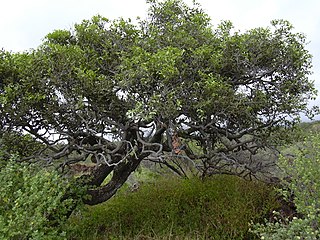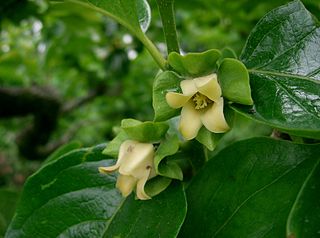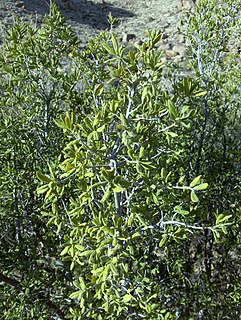
The persimmon is the edible fruit of a number of species of trees in the genus Diospyros. The most widely cultivated of these is the Oriental persimmon, Diospyros kaki. Diospyros is in the family Ebenaceae, and a number of non-persimmon species of the genus are grown for ebony timber. In 2019, China produced 75% of the world total of persimmons.

Ebony is a dense black/brown hardwood, most commonly yielded by several species in the genus Diospyros, which also contains the persimmons. Ebony is dense enough to sink in water. It is finely textured and has a mirror finish when polished, making it valuable as an ornamental wood. The word ebony comes from the Ancient Egyptian hbny, through the Ancient Greek ἔβενος, into Latin and Middle English.

The Ebenaceae are a family of flowering plants belonging to order Ericales. The family includes ebony and persimmon among about 768 species of trees and shrubs. It is distributed across the tropical and warmer temperate regions of the world. It is most diverse in the rainforests of Malesia, India, tropical Africa and tropical America.

Diospyros is a genus of over 700 species of deciduous and evergreen trees and shrubs. The majority are native to the tropics, with only a few species extending into temperate regions. Individual species valued for their hard, heavy, dark timber, are commonly known as ebony trees, while others are valued for their fruit and known as persimmon trees. Some are useful as ornamentals and many are of local ecological importance. Species of this genus are generally dioecious, with separate male and female plants.

Diospyros virginiana is a persimmon species commonly called the American persimmon, common persimmon, eastern persimmon, simmon, possumwood, possum apples, or sugar plum. It ranges from southern Connecticut to Florida, and west to Texas, Louisiana, Oklahoma, Kansas, and Iowa. The tree grows wild but has been cultivated for its fruit and wood since prehistoric times by Native Americans.

Diospyros melanoxylon, the Coromandel ebony or East Indian ebony, is a species of flowering tree in the family Ebenaceae native to India and Sri Lanka; it has a hard, dry bark. Its common name derives from Coromandel, the coast of southeastern India. Locally it is known as temburini or by its Hindi name tendu. In Odisha, Jharkhand, and Assam, it is known as kendu. The leaves can be wrapped around tobacco to create the Indian beedi, which has outsold conventional cigarettes in India. The olive-green fruit of the tree is edible

Gracillariidae is an important family of insects in the order Lepidoptera and the principal family of leaf miners that includes several economic, horticultural or recently invasive pest species such as the horse-chestnut leaf miner, Cameraria ohridella.

Diospyros kaki, the Oriental persimmon, Chinese persimmon, Japanese persimmon or kaki persimmon, is the most widely cultivated species of the genus Diospyros. Although its first botanical description was not published until 1780, D. kaki is among the oldest cultivated plants, having been in use in China for more than 2000 years.

Diospyros discolor is a tree of the genus Diospyros of ebony trees and persimmons. Its edible fruit has a skin covered in a fine, velvety fur which is usually reddish-brown, and soft, creamy, pink flesh, with a taste and aroma comparable to a peach. It is indigenous to the Philippines, where kamagong usually refers to the entire tree, and mabolo or tálang is applied to the fruit.

Diospyros pentamera is a common rainforest tree in the Ebony or Persimmon family (Ebenaceae) growing from near Batemans Bay in New South Wales to the Atherton Tableland in tropical Queensland, Australia. It is commonly known as the myrtle ebony, black myrtle, grey plum or grey persimmon.

Diospyros texana is a species of persimmon that is native to central, south and west Texas and southwest Oklahoma in the United States, and eastern Chihuahua, Coahuila, Nuevo León, and Tamaulipas in northeastern Mexico. Common names include Texas persimmon, Mexican persimmon and the more ambiguous "black persimmon". It is known in Spanish as chapote, chapote manzano, or chapote prieto, all of which are derived from the Nahuatl word tzapotl. That word also refers to several other fruit-bearing trees.
Caloptilia mabaella, the Hawaiian ebony leaf miner, is a moth of the family Gracillariidae. It was first described by Otto Herman Swezey in 1910. It is only known from the Hawaiian island of Oahu in the United States.

Diospyros whyteana is a small African tree of the ebony family. Bearing dark green, strikingly glossy leaves and creamy fragrant flowers, it is increasingly cultivated in Southern African gardens as an attractive and strong ornamental tree. It can attain a height of up to 6 m.
Pleiomorpha eumeces is a moth of the family Gracillariidae. It is known from South Africa.
Pleiomorpha homotypa is a moth of the family Gracillariidae. It is found in South Africa.
Cuphodes diospyri is a moth of the family Gracillariidae. It is known from South Africa.
Cuphodes diospyrosella is a moth of the family Gracillariidae. It is known from Japan. The wingspan is 7.0–8.5 mm. Leaf miners, the diospyrosella larvae feed on the mesophyll of the Diospyros species.

Gracillariinae are a subfamily of moths which was described by Henry Tibbats Stainton in 1854.

Diospyros maritima is a tree in the family Ebenaceae. The specific epithet maritima means "by the sea", referring to the tree's habitat.













